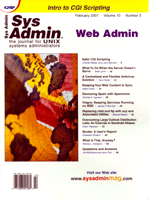 Books:
A User's Report Books:
A User's Report
Elizabeth Zinkann
This month's reviews range from a Linux and DNS book, to
a compact and complete guide to the Internet, a hardware book, and
a database manual. Specifically, they include: Linux DNS Server
Administration by Craig Hunt, The Craig Hunt Linux Library (Sybex);
The Rough Guide to the Internet, Sixth Edition by Angus J.
Kennedy (Rough Guides, Ltd., Distributed by the Penguin Group);
PC Hardware in a Nutshell by Robert Bruce Thompson and Barbara
Fritchman Thompson, Foreword by Jerry Pournelle (O'Reilly &
Associates, Inc.); and MySQL by Paul DuBois, Foreword by
Michael "Monty" Widenius (New Riders).
Linux DNS Server Administration
Craig Hunt
The Craig Hunt Linux Library
Sybex
ISBN 0-7821-2736-3
423 Pages
$39.99
http://www.sybex.com
Everyone uses the Domain Name System; systems and network administrators
(hopefully) understand it. In Linux DNS Server Administration,
Craig Hunt discusses and details the related concepts and implementation
of DNS within the Linux operating system environment. Hunt addresses
this topic through four major sections plus the Appendixes. The
divisions include: How Things Work, Essential Configuration, Advanced
Configurations, and Maintaining a Healthy System. Part 1, How Things
Work, explores The DNS Architecture, The DNS Protocols, and The
BIND Software. The author surveys the /etc/hosts file, Internet
protocols, the format of the DNS message, the named command
and how to enable it within both BSD and System V Linux systems,
how to compile new BIND releases, and optional ways to install BIND.
The Essential Configuration section analyzes Configuring the Resolver,
Caching and Slave Server Configuration, and Creating a Master Server.
These chapters discuss default configurations, the basic configuration
files (resolv.conf, host.conf, nsswitch.conf,
and named.conf) plus the commands and directives used within
them. In Advanced Configurations, Hunt describes Creating Subdomains,
Special BIND Configuration, Dynamic DNS and their options, advantages,
and disadvantages. Maintaining a Healthy System illustrates DNS
Security, Testing DNS, and the BIND Log Files. The security chapter
includes basic hardware and software security, encryption, authentication,
and some aspects of firewalls. The BIND log files reviews the dump,
statistics, and trace files, system messages, and configuring logging
capabilities. The appendixes comprise: A) BIND 9, B) named.conf
Command Reference, C) Resource Record Reference, and D) Configuring
Network Information Service.
Linux DNS Server Administration provides administrators
with an invaluable and comprehensive reference. Good documentation
is often elusive; great explanations are rare. Hunt presents a thorough
and knowledgeable explanation of DNS and BIND for the Linux operating
system. I used it almost immediately for confirmation, research,
and procedures. Hunt's well-written descriptions and examples
combined with his extensive expertise make Linux DNS Server Administration
an outstanding and dynamic reference for every Linux administrator.
The Rough Guide to the Internet
Sixth Edition
Angus J. Kennedy
Rough Guides, Ltd.
Distributed by the Penguin Group (no relation to Tux)
ISBN 185828-551-8
528 Pages, 4" x 5.75"
$9.95
http://www.roughguides.com
http://www.penguinputnam.com
In his latest edition, Kennedy once again provides the reader
with a remarkable treasure trove of information, references, and
procedures. Written in English (as opposed to acronyms, geekspeak,
and technobabble), the author describes how a search engine (or
MP3 or a newsgroup, etc.) works, what resources you need to access
it, and the basic processes to do it. Kennedy presents information
through four sections: Basics, The Guide, Contexts, and the ISP
Directory.
The first part, Basics, contains most of the book's explanations.
The initial section includes chapters on: FAQs, Getting Connected,
Connection Software, The Web Browser, Connecting, Surfing the Web,
Email, Mailing Lists, Newsgroups, Downloading Software, Finding
It, Chat, Shopping, MP3 and Online Radio, Online Gaming, Creating
Your Own Web Page, and On the Road. The second section, The Guide,
features a bountiful selection of World Wide Web Sites plus a Software
Roundup. Contexts, the following section, surveys A Brief History
of the Net, Net Language, and a Glossary, while the concluding section,
ISP Directory, provides Internet Service Providers and 51 Things
To Do. The newest additions to the book are the Shopping and MP3
chapters; the latter also details some distinctions of copyright
law and what practices are illegal. Many of the chapters must be
read to be thoroughly appreciated. For example, the chapter entitled
Internet Service Providers isn't just a listing of ISPs; it
also includes questions to ask, basic features to expect, and costs
to consider. The "Finding It" chapter demonstrates how
to search effectively (and successfully) for a topic and The Guide
furnishes over 2000 sites and subjects to explore.
This is an outstanding book on the Internet's features and
techniques. Kennedy's direct approach and straightforward analyses
enable The Rough Guide to the Internet to be a reference
as well as a resource. Its 4-inch by 5.75-inch size makes it an
"anywhere reference", ideally suited for both the mobile
user and readers in the more traditional desktop computing environment.
The number of topics and the amount of accompanying information
is amazing. Whether Kennedy used compression, optimization, or just
plain magic, the result is a large Internet resource in a small
package. Both beginning surfers and experienced navigators will
appreciate its compact size and encyclopedic content.
PC Hardware in a Nutshell
Robert Bruce Thompson and Barbara Fritchman Thompson
Foreword by Jerry Pournelle
O'Reilly & Associates, Inc.
500 Pages
ISBN 1-56592-599-8
$29.95
http://www.oreilly.com
http://www.hardwareguys.com
The dynamic technology of PC hardware continues to advance at
an amazing speed. A hardware technician barely has time to assemble
a system before the next new development is released. With new processors
and chipsets, there are different architectures and motherboards
to consider. As I write this, there are Socket 7, Socket 8, Slot
1, Slot A, Socket 370, and Socket A, to mention the most popular
selections. (Pentium 4 is on the horizon; Crusoe is just debuting
in select notebooks.) Implementation is not always easily or smoothly
achieved, as the number of newsgroup postings asking for help indicates.
PC Hardware in a Nutshell provides many excellent resources
and guidelines. The Thompsons discuss buying considerations, detail
installation procedures, and summarize data in easily referenced
tables. The authors begin the book with two general chapters: Fundamentals
and Working on PCs. These address PC components, upgrading, buying
practices, tools, and some basic installation techniques. They feature
the characteristics and idiosyncrasies of computer components and
peripherals including: Motherboards, Processors, Memory, Floppy
Disk Drives, Removable Hard Disk Drives, Tape Drives, CD-R and CD-RW
Drives, DVD Drives, Monitors, Sound Cards, Game Controllers, Cases,
and Power Supplies. The concluding chapters demonstrate Designing
A PC and Building A PC. The authors also present their favorite
components at the end of each chapter through a section called Our
Picks. They offer updates, current developments, an email address
for reader's questions and comments, and book Errata on their
Web site: http://www.hardwareguys.com.
PC Hardware in a Nutshell is a superb book for anyone upgrading
or maintaining a system (and learning how to do it). The Thompsons
share favorite tips and techniques, demonstrate how to upgrade (or
build) a system, and identify when upgrading just isn't worth
it.
The design process is usually the most time consuming part of
system assembly; one of the most important sentences in the chapter
appears in the introduction:
"When you design a system, the most you can hope for is to
choose good components at a good price at that moment in time."
(Page 425)
(Usually, everything is less expensive and faster two weeks later,
unless you decide to wait two weeks.) The final chapter, Building
a PC, shows the reader exactly how to assemble a computer, both
through step-by-step descriptions and accompanying photographs.
Throughout the book, the authors illustrate their extensive knowledge
of computer hardware complexities, identify problems you may encounter,
and relate frustration-saving procedures. PC Hardware in a Nutshell
is must for anyone upgrading or building a computer system.
MySQL
Paul DuBois
Foreword by Michael "Monty" Widenius
New Riders
ISBN 0-7357-0921-1
756 Pages
$49.99
http://www.newriders.com
Databases provide an organized way to store information for full
or partial retrieval and routine access. Whether your database is
a simple collection of names and addresses for a mailing list or
a more complex description of inventory that changes daily, it can
be maintained through MySQL. Available for both Open Source and
Windows platforms, MySQL easily interfaces with Perl, PHP, and Apache.
MySQL by Paul DuBois presents a straightforward and interesting
way to learn and implement the features of MySQL for your individual
databases.
DuBois addresses the concepts and programming constructs of MySQL
through four major sections: General MySQL Use, Using MySQL Programming
Interfaces, MySQL Administration, and the Appendices. The first
section contains an Introduction to MySQL and SQL, Working with
Data in MySQL, MySQL SQL Syntax and Use, and Query Optimization.
The author presents a MySQL Tutorial and describes two examples
(The U.S. Historical League and a Grade-keeping scenario), which
he uses throughout the text. He then illustrates the commands to
create and use them. In Query Optimization, DuBois demonstrates
which query combinations are the most efficient and economize system
resources most effectively. The second section, Using MySQL Programming
Interfaces, includes: an Introduction to MySQL Programming, The
MySQL C API, The Perl DBI API, and the PHP API. In the following
part, MySQL Administration, DuBois discusses an Introduction to
MySQL Administration, The MySQL Data Directory, General MySQL Administration,
Security, and Database Maintenance and Repair. The final section,
Appendices, details A) Obtaining and Installing Software, B) Column
Type Reference, C) Operator and Function Reference, D) SQL Syntax
Reference, E) MySQL Program Reference, F) C API Reference, G) Perl
DBI API Reference, H) PHP API Reference, I) Useful Third-Party Tools,
and J) Internet Service Providers.
The book MySQL (to differentiate it from the program) describes
the uses, processes, whys, and wherefores of database programming
with MySQL. DuBois not only demonstrates how to implement an RDBS
(relational database system), but also how to do it efficiently.
His use of the examples clearly illustrates the programming concepts
by showing how to create and achieve the properties within the two
databases. This is a superior guide to MySQL creation and use that
will simplify MySQL for programmers, Web designers, and administrators.
Elizabeth Zinkann has been involved in the UNIX and C environment
for the past 15 years. She is currently a UNIX and C consultant,
and one of her specialties is UNIX education. In addition to her
computer science background, she also has a degree in English. Her
writing has also appeared in Linux Magazine, Performance
Computing, and Network Administrator. Elizabeth can be
reached at: elizabeth@equillink.com.
|

